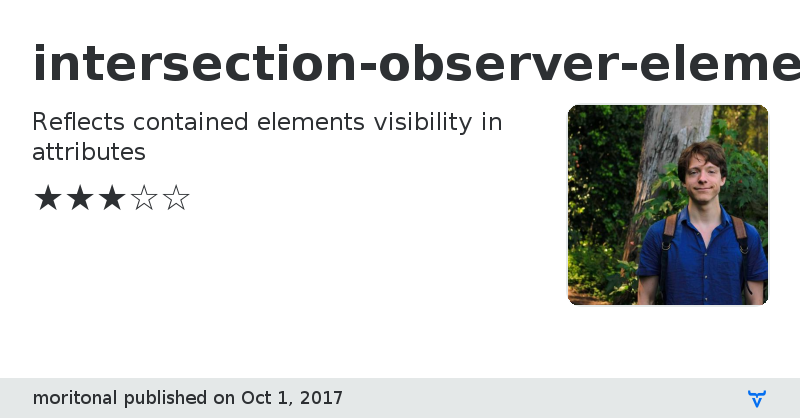intersection-observer-element - Vaadin Add-on Directory
Reflects contained elements visibility in attributes
**[ This description is mirrored from README.md at [github.com/moritonal/intersection-observer-element](https://github.com//moritonal/intersection-observer-element/blob/v1.0.8/README.md) on 2019-05-22 ]**
# \
[](https://www.webcomponents.org/element/Glitch0011/intersection-observer-element)
Set's `visible` to true when the viewport crosses the set threshold of the element.
```
```
## Install
```
bower install --save intersection-observer-element
```
## Options
### thresholds
Default: [0.0, 0.25, 0.5, 0.75, 1.0]
The percentages across the element where an event is raised that the intersection has changed.
### visibleLimit
Default: 0.5
The percentage whereby the element swaps between visible or not.
### rootMargin
Default: 0px
Directly passed into IntersectionObserver class as rootMargin
## Polyfills
This element uses the Intersection Observer Api, which whilst most modern browsers currently support, it is missing from iOS Safari. More detailed information can be found at [CanIUse](https://caniuse.com/#search=intersection).
If you wish to support multiple browsers it's recommended you also use one of the Polyfills from [here](https://github.com/w3c/IntersectionObserver/tree/gh-pages/polyfill).
## Developing
### Install the Polymer-CLI
First, make sure you have the [Polymer CLI](https://www.npmjs.com/package/polymer-cli) installed. Then run `polymer serve` to serve your element locally.
### Viewing Your Element
```
$ polymer serve
```
### Running Tests
```
$ polymer test
```
Your application is already set up to be tested via [web-component-tester](https://github.com/Polymer/web-component-tester). Run `polymer test` to run your application's test suite locally.
Online Demo
...
Documentation
GitHub Homepage
Issue tracker
View on GitHub
intersection-observer-element version 1.0.0
### Dependencies
* polymer#Polymer/polymer#^2.0.0
intersection-observer-element version 1.0.1
### Dependencies
* polymer#Polymer/polymer#^2.0.0
intersection-observer-element version 1.0.2
### Dependencies
* polymer#Polymer/polymer#^2.0.0
intersection-observer-element version 1.0.3
### Dependencies
* polymer#Polymer/polymer#^2.0.0
intersection-observer-element version 1.0.4
### Dependencies
* polymer#Polymer/polymer#^2.0.0
intersection-observer-element version 1.0.7
### Dependencies
* polymer#Polymer/polymer#^2.0.0
intersection-observer-element version 1.0.8
### Dependencies
* polymer#Polymer/polymer#^2.0.0